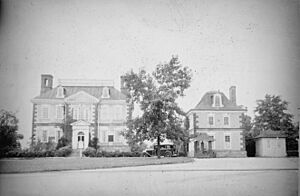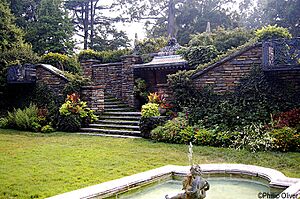Dumbarton Oaks facts for kids
Quick facts for kids Dumbarton Oaks |
|
|---|---|
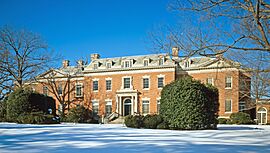 |
|
| University | Harvard University |
| Location | Washington D.C. |
| Coordinates | 38°54′51″N 77°3′48″W / 38.91417°N 77.06333°W |
| Founders | Robert Woods Bliss Mildred Barnes Bliss |
| Established | 1801 |
| Founded | 1940 |
Dumbarton Oaks is a famous historic estate in the Georgetown area of Washington, D.C.. It was once the home and beautiful gardens of a wealthy U.S. diplomat named Robert Woods Bliss and his wife, Mildred Barnes Bliss. The Bliss couple created this estate and then gave it to Harvard University in 1940.
In 1944, Dumbarton Oaks was the location of the important Dumbarton Oaks Conference. This meeting helped create the plans for the United Nations after World War II. A part of the estate's natural area was given to the National Park Service. It is now known as Dumbarton Oaks Park.
Today, Dumbarton Oaks is a research center that helps people study different topics. These include Byzantine history (the Eastern Roman Empire), Pre-Columbian cultures (ancient Americas), and garden design. It offers special programs, meetings, and publishes books. You can also visit its gardens and museum, and enjoy public talks and concerts. Dumbarton Oaks is different from Dumbarton House, which is another historic house museum in Georgetown.
Contents
History of Dumbarton Oaks
Early Beginnings
The land where Dumbarton Oaks stands was first part of a large area given by Queen Anne in 1702. Around 1801, William Hammond Dorsey built the first house on the property. This house is the main part of the building you see today. Later, Edward Magruder Linthicum made the house much bigger in the mid-1800s and called it "The Oaks." It was also the home of Senator and Vice President John C. Calhoun from 1822 to 1829.
In 1846, Edward Linthicum bought the house and made it even larger. Henry F. Blount bought it in 1891.
The Bliss Family Era
Mildred and Robert Woods Bliss bought the property in 1920. In 1933, they named it Dumbarton Oaks, combining its old names. The Blisses hired architect Frederick H. Brooke to update and expand the house between 1921 and 1923. They turned it into a beautiful Colonial Revival style home.
Over time, the Blisses made the property much larger, reaching about 54 acres (22 hectares). They worked with landscape architect Beatrix Farrand to design amazing terraced gardens and a wilder "wilderness" area. The Blisses also added other buildings, like service buildings and a music room.
After retiring in 1933, the Blisses started planning a research center. They collected many artworks and books, which became the start of the Research Library and Collection. In 1938, they had two new buildings constructed to hold their Byzantine art collection and a large library. In 1940, they gave Dumbarton Oaks, including about 16 acres (6.5 hectares) of land, to Harvard University. They also gave about 27 acres (11 hectares) of the grounds to the National Park Service to create Dumbarton Oaks Park.
In the early 1960s, the Blisses helped build two new wings to expand the research mission. One wing, designed by Philip Johnson, holds the Pre-Columbian Art Collection. The other, designed by Frederic Rhinelander King, is a garden library for books on plants and garden history.
The Dumbarton Oaks Concerto
In 1937, Mildred Bliss asked the famous composer Igor Stravinsky to write a special piece of music. It was to celebrate the Blisses' 30th wedding anniversary. The music, called the Concerto in E-flat, was first performed on May 8, 1938, in the Dumbarton Oaks music room. Stravinsky himself conducted the concerto there again in 1947 and 1958.
The Dumbarton Oaks Conference
In 1944, during World War II, very important meetings happened at Dumbarton Oaks. These meetings were called the Washington Conversations on International Peace and Security Organization. Representatives from China, the Soviet Union, the United Kingdom, and the United States met. They discussed plans for creating an organization to keep peace and safety around the world. Their discussions led to the United Nations Charter, which was officially adopted in San Francisco in 1945.
After the Bliss Family
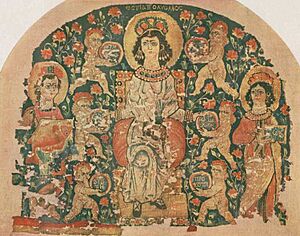
Mildred Bliss passed away in 1969. She wanted Dumbarton Oaks to continue being a place for high-quality learning and art. She believed it should be a home for the humanities, where gardens and trees are also important.
Since then, Dumbarton Oaks has continued to grow and support important research. It has funded archaeological digs and art restoration projects in many parts of the world. In 2005, a new library building was opened, designed by Robert Venturi. The main house and museum also underwent a big renovation in 2008.
Research and Studies
Dumbarton Oaks helps and supports research in three main areas:
- Byzantine Studies: This program, started in 1940, focuses on the history and culture of the Byzantine Empire (from the 4th to the 15th centuries). It also looks at how the Byzantine Empire interacted with other cultures.
- Pre-Columbian Studies: This program began in 1963. It supports the study of art and archaeology from the ancient Americas. This includes cultures from Mexico to South America, from the earliest times until the 16th century.
- Garden and Landscape Architecture Studies: This program, started in 1969, supports the study of gardens and the history of landscape design around the world. It covers everything from ancient times to today.
Through these programs, Dumbarton Oaks invites scholars from all over the world to do research. It also gives grants for archaeological work and publishes scholarly books and journals. Public lectures, symposia, and colloquia are also held regularly.
Museum and Collections
The Dumbarton Oaks Museum has collections of Byzantine and Pre-Columbian art. It also features European artworks and furniture. The Bliss couple started these collections and planned for future additions.
The Byzantine Collection has over 1,200 objects from the 4th to the 15th centuries. These include beautiful items made of precious materials, mosaics, textiles, coins, and seals.
The Robert Woods Bliss Collection of Pre-Columbian Art includes objects from ancient cultures of Mesoamerica, the Intermediate Area, and the Andes. You can see stone sculptures, jade carvings, and pottery from cultures like the Aztec, Maya, Olmec, and Nasca. There are also gold and silver objects and textiles, showing the amazing skills of ancient craftspeople.
The House Collection includes the historic buildings and their interiors. It also has Asian, European, and American artworks and furniture. A highlight is the Music Room, which has a unique ceiling and floor design. The Blisses used this room for music and lectures, and it is still used for these events today.
Philip Johnson Pre-Columbian Pavilion
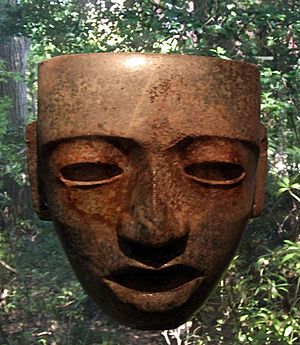
In 1959, the Blisses asked architect Philip Johnson to design a special building for the Pre-Columbian Art Collection. This building has eight round galleries with domes, arranged in a perfect square around a central fountain. Johnson designed it to blend with the surrounding trees and garden. He wanted the garden to feel like it was "marching right up to the museum displays." The curved glass walls and indoor planter areas help connect the inside with the outside.
The pavilion's design allows visitors to move easily between the galleries. Each gallery is a cozy space to enjoy and study the Pre-Columbian objects.
The Library
The Dumbarton Oaks Research Library holds over 200,000 items. These support the three main study programs. The Byzantine collection alone has 149,000 books and over 550 journal subscriptions.
In 1964, the library received Robert Woods Bliss's personal collection of rare books on Pre-Columbian art and archaeology. Mildred Bliss's garden library, with rare books and prints, also became part of the collection. The Rare Book Collection now has over 10,000 rare books, prints, drawings, and photographs.
The Rare Book Room, designed by Frederick Rhinelander King, looks like an 18th-century library. It was finished in 1963. The Research Library is in a separate building, completed in 2005.
The library's collection includes old books with illustrations of gardens, plants, and architecture. These books are very important for studying how gardens looked in the past. For example, there are 17th-century pictures of gardens in Rome and Versailles. There are also early books on botany (the study of plants) and horticulture (garden cultivation). Some of the oldest printed books with woodcut illustrations are here, like the Herbarius Latinus from 1486.
The collection also has many beautiful plant illustrations. As botany developed, so did the art of drawing plants. The library owns works by famous artists like Pierre-Joseph Redouté, known for his detailed color prints of flowers.
Besides printed books, there are also manuscripts and drawings. These include old garden plans and paintings of new plants discovered during explorations. The library continues to add to its collection, making it a unique resource for learning about gardens and human history.
Image Collections and Fieldwork Archives
The Image Collections and Fieldwork Archives contain over 500,000 images. Most of these are related to Byzantine subjects. There are also growing collections of photographs and archives for Pre-Columbian and garden studies.
The Gardens
In 1921, the Blisses hired landscape designer Beatrix Farrand to create the gardens at Dumbarton Oaks. Mildred Bliss worked closely with Farrand for nearly 30 years. They transformed the old farmlands into beautiful terraced garden "rooms" and scenic views. The garden moves from formal, elegant terraces near the house to a more relaxed area with pools, a tennis court, and orchards. At the far end of the property, there is a wilder area with meadows and a stream.
The gardens at Dumbarton Oaks first opened to the public in 1939. The Dumbarton Oaks Park is a 27-acre (11-hectare) natural park with a stream valley. It is part of Rock Creek Park.
Events and Activities
Music at Dumbarton Oaks
Since 1946, Dumbarton Oaks has hosted "Friends of Music" concerts. These chamber music concerts are held yearly in the music room. In 1958, Dumbarton Oaks asked Aaron Copland to compose a piece for the Blisses' 50th wedding anniversary. This piece, called "Nonet for Strings," was first performed in 1961. In 2006, Joan Tower was asked to compose "Dumbarton Quintet," which premiered in 2008. The concert series is now called "Music at Dumbarton Oaks."
Public Lectures
Dumbarton Oaks regularly offers public lectures in the Oak Room of the Fellowship House. These talks often share new discoveries or interesting research that the public would enjoy.
Directors
- John Seymour Thacher, 1945–1969
- William R. Tyler, 1969–1977
- Giles Constable, 1977–1984
- Robert W. Thomson, 1984–1989
- Angeliki Laiou, 1989–1998
- Edward L. Keenan, 1998–2007
- Jan M. Ziolkowski, 2007–2020
- Thomas B.F. Cummins, 2020–Present
See also
 In Spanish: Dumbarton Oaks para niños
In Spanish: Dumbarton Oaks para niños
- List of botanical gardens and arboretums in the United States
- Tudor Place
- Architecture of Washington, D.C.


